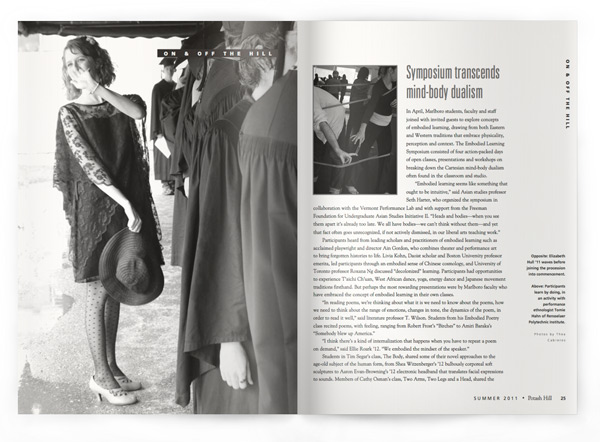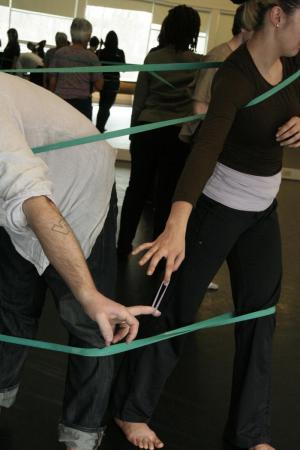Symposium transcends mind-body dualism

In April, Marlboro students, faculty and staff joined with invited guests to explore concepts of embodied learning, drawing from both Eastern and Western traditions that embrace physicality, perception and context. The Embodied Learning Symposium consisted of four action-packed days of open classes, presentations and workshops on breaking down the Cartesian mind-body dualism often found in the classroom and studio.
“Embodied learning seems like something that ought to be intuitive,” said Asian studies professor Seth Harter, who organized the symposium in collaboration with the Vermont Performance Lab and with support from the Freeman Foundation for Undergraduate Asian Studies Initiative II. “Heads and bodies—when you see them apart it’s already too late. We all have bodies—we can’t think without them—and yet that fact often goes unrecognized, if not actively dismissed, in our liberal arts teaching work.”
Participants heard from leading scholars and practitioners of embodied learning such as acclaimed playwright and director Ain Gordon, who combines theater and performance art to bring forgotten histories to life. Livia Kohn, Daoist scholar and Boston University professor emerita, led participants through an embodied sense of Chinese cosmology, and University of Toronto professor Roxana Ng discussed “decolonized” learning. Participants had opportunities to experience T’aichi Ch’uan, West African dance, yoga, energy dance and Japanese movement traditions firsthand. But perhaps the most rewarding presentations were by Marlboro faculty who have embraced the concept of embodied learning in their own classes.

“In reading poems, we’re thinking about what it is we need to know about the poems, how we need to think about the range of emotions, changes in tone, the dynamics of the poem, in order to read it well,” said literature professor T. Wilson. Students from his Embodied Poetry class recited poems, with feeling, ranging from Robert Frost’s “Birches” to Amiri Baraka’s “Somebody blew up America.”
“I think there’s a kind of internalization that happens when you have to repeat a poem on demand,” said Ellie Roark ’12. “We embodied the mindset of the speaker.”
Students in Tim Segar’s class, The Body, shared some of their novel approaches to the age-old subject of the human form, from Shea Witzenberger’s ’12 bulbously corporeal soft sculptures to Aaron Evan-Browning’s ’12 electronic headband that translates facial expressions to sounds. Members of Cathy Osman’s class, Two Arms, Two Legs and a Head, shared the results of experimentally restraining their painting stroke to remind themselves of the physicality of painting. Students reported that they found the experiment freeing, even comforting, and the resulting figure paintings felt less contrived.
“‘I think therefore I am’ no longer sufficiently explains a lot of things that are going on in terms of social movements inspired by desires,” said politics professor Meg Mott in a presentation from her class, Spinoza & Freedom. She described going beyond students’ thoughts to make their emotional reactions to subjects part of the class discussion. “Maybe Spinoza’s tagline would be ‘I think I am affected, therefore I am empowered.”
Visiting language professor Michael Huffmaster discussed the bodily basis of semantics and thought, and ceramics professor Martina Lantin and visiting photography professor Lakshmi Luthra ’05 discussed art theory and practice. Anthropology professor Carol Hendrickson and Sari Brown ’11 talked about their recent visit to Bolivia, inspired by Sari’s field research there and by a course taught last fall by Carol and religion professor Amer Latif called Thinking Through the Body.
“Starting a few years ago, in the course of conversations with students and colleagues, I started to see a strange phenomenon—people started to talk about these ideas of embodiment,” said Seth, who led a discussion based on his class, Making Way: Daoist Ritual and Practice. “People started to question the epistemological significance of the connections between the mind and the body and the cost of ignoring those connections. They questioned bracketing out feelings or emotions or sensory input or physical limitation from the kind of work we were doing, even in history class or philosophy class. I saw the Embodied Learning Symposium as an opportunity for those conversations to come together.”
